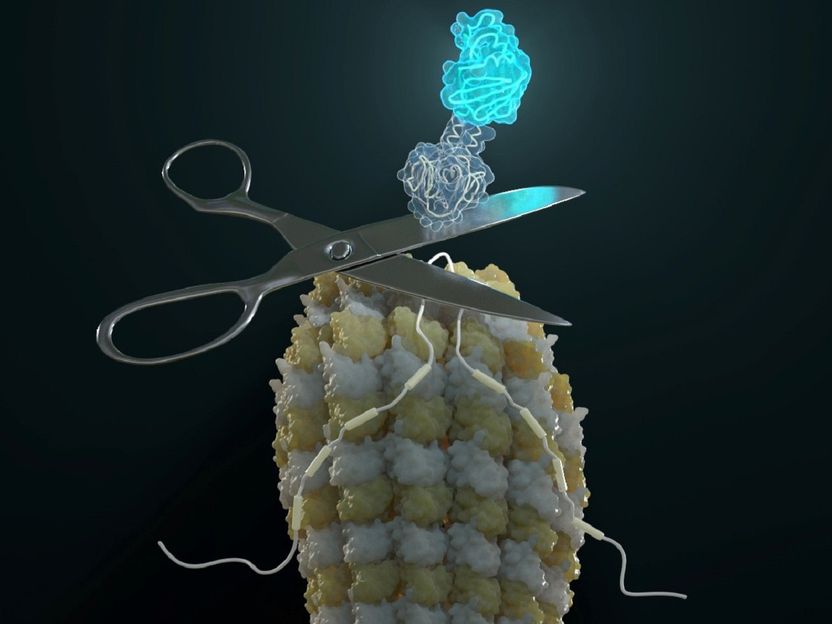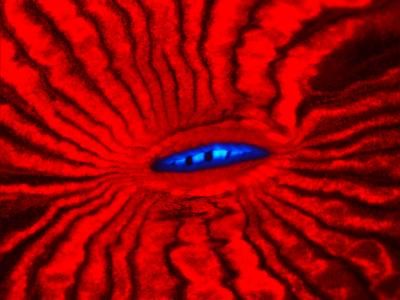The Cut and Restore Protein Trick: Self-Excising Designer Proteins Report Isoform Expression
Our proteome is much bigger than our genome because one gene produces several variants of proteins called protein isoforms, whose disbalance is implicated in many diseases. A new bioengineered reporter system developed at Helmholtz Zentrum München and the Technical University of Munich now allows for the first time to follow protein isoform Expression over time in live cells. The method helps to decipher the underlying regulatory mechanisms and enables screening for potential molecular interventions.

“Cut and restore protein trick”
©Barth van Rossum
Proteins are the key players in our cellular processes. Their generation follows principles called transcription and translation. First, DNA copies its genetic information to messenger RNA (mRNA), which then determines the sequence in a chain of amino acids, which finally fold into a protein. The reality, however, is more complex: More than 90 per cent of our genes do not result in only one mRNA and then one protein, but a process called alternative splicing produces several mRNA variants, only some of which are then translated into a specific protein isoform in a specific cell at a given time. Conventional techniques to detect alternative splicing are mostly single time-point measurements that are work-intense and cannot reliably monitor over time which protein isoforms are actually translated in the cell.
Researchers at Helmholtz Zentrum München and the Technical University of Munich (TUM) thus developed a new bioengineered reporter system called EXSISERS. The idea behind it is to generate a signal such as light as soon as a specific protein isoform is being translated. “This is possible via designer reporter proteins that can cut themselves out of the nascent amino acid chain– they are self-excising,” says Dong-Jiunn Jeffery Truong. “In analogy to the famous cut and restore rope trick in magic performances, the excision of the reporter leaves no scar in the natural protein isoforms.” The researchers have already applied this method to human cells in culture. One of their aims was to analyze the expression of isoforms of a protein called Tau, which is associated with neurodegenerative diseases such as Parkinson’s. This makes Tau isoforms a potential target for future molecular therapies.
“Bioengineering inspired by natural biomolecular processes will make it possible to observe many other fundamental cellular processes non-invasively,” says Gil Gregor Westmeyer. “The more cellular parameters we can monitor, the better we can develop targeted molecular interventions for future cellular therapies, for example, to treat neurodegenerative diseases.” Westmeyer and his team are already collaborating with several academic laboratories that use the new reporter system to obtain a more comprehensive understanding of isoform expression in cells and its implication in diseases.
Original publication
Other news from the department science
These products might interest you

Kjel- / Dist Line by Büchi
Kjel- and Dist Line - steam distillation and Kjeldahl applications
Maximum accuracy and performance for your steam distillation and Kjeldahl applications

AZURA Purifier + LH 2.1 by KNAUER
Preparative Liquid Chromatography - New platform for more throughput
Save time and improve reproducibility during purification

Get the analytics and lab tech industry in your inbox
By submitting this form you agree that LUMITOS AG will send you the newsletter(s) selected above by email. Your data will not be passed on to third parties. Your data will be stored and processed in accordance with our data protection regulations. LUMITOS may contact you by email for the purpose of advertising or market and opinion surveys. You can revoke your consent at any time without giving reasons to LUMITOS AG, Ernst-Augustin-Str. 2, 12489 Berlin, Germany or by e-mail at revoke@lumitos.com with effect for the future. In addition, each email contains a link to unsubscribe from the corresponding newsletter.
























































